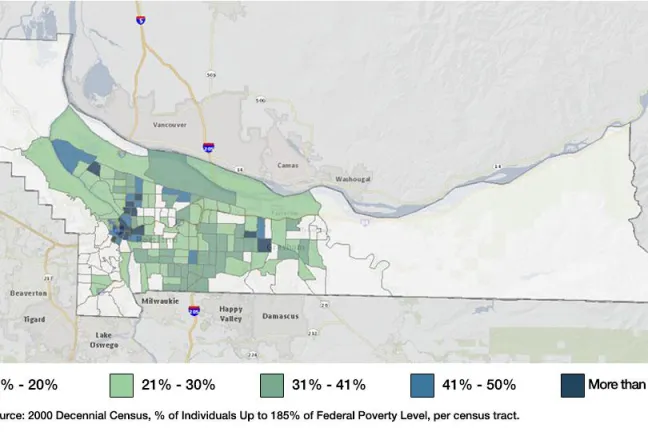A report released today by the Office of the Multnomah County Auditor found that social services provided directly through county departments or during in-home visits are best able to keep pace with the changing demographics of its clients.
As rental and mortgage hikes push poor and minority residents out of inner Portland to east Multnomah County, the county’s primary care clinics and mental health services are well-placed to meet the needs of low-income residents.
The auditor identified 55 county programs with a budget of $1 million or more that provide social services to vulnerable residents. It plotted those services on a map, adding demographic census layers including poverty, race and ethnicity.
The auditor’s team found in most cases programs are well placed to deliver services to the populations they intend to serve. Departments are anticipating how demographics will change when they plan new investments in infrastructure. In many cases, programs take advantage of Geographic Information System (GIS) resources to map client populations, eligible populations and service locations.
“You have worked hard to try and make these services accessible to people, and I commend you for that,” County Auditor Steve March told the Board of County Commissioners during a board meeting Thursday.
Maps show mental health outpatient providers, with which the county contracts, may not be well positioned to serve their low-income clients because they often operate out of offices established before major demographic shifts happened.
“Generally, facilities are better placed where the county has greater flexibility or control,” performance auditor Jennifer McGuirk told the board. “Population changes can impact how well a physical location fits its intended recipients.”
Home-based services such as the county’s Nurse-Family Partnership and school-based mental health services that don’t require a formal clinic are more flexible and therefore more able to adapt to shifting demographics.
Principal auditor Mark Ulanowicz explained that tight budgets and tight space, not unwillingness, can be to blame for locations in which services aren’t meeting the needs of the county’s most vulnerable residents.
“It’s not a willingness issue,” Ulanowicz said. “Limited resources are the primary barrier to a better match.”
He offered the example of a county program and a food bank that wanted space in an East County school. “But East County schools are some of the most overcrowded in county. So we have a program that’s willing and a community partner that’s willing and a school that’s willing, but it just doesn’t have the space.”
County Commissioner Diane McKeel thanked the office of the auditor for its work and encouraged them to come back. “I would like to see this presented regularly so we know what’s happening with our services,” she said.
County Commissioner Loretta Smith agreed it would be helpful during the next budget process for departments to review as they consider how and where to allocate resources. And even after budgets have been fixed, “It’s good to know if we need to fill some gaps,” she said.

